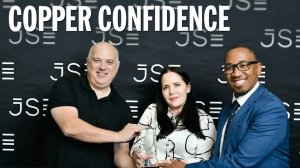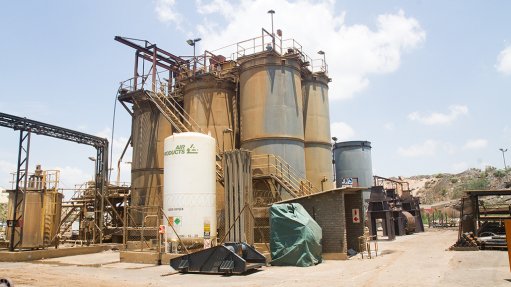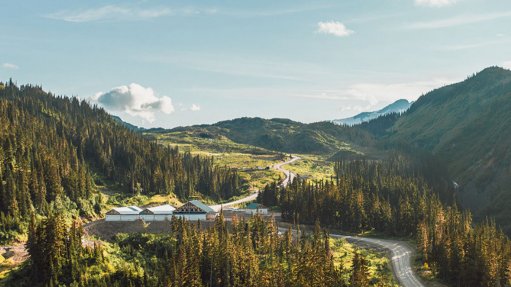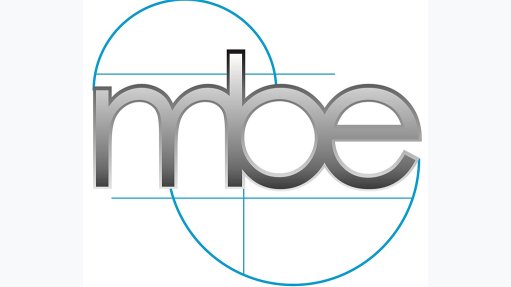Funded Copper 360 advancing in South Africa’s Northern Cape

Copper 360 CEO Jan Nelson interviewed by Engineering News & Mining Weekly’s Martin Creamer
The business of Copper 360, a company that listed on the Alternative Exchange (AltX) of the Johannesburg Stock Exchange (JSE) this year, is focused on the processing of historical mined copper rock dumps, through a procedure of environmental clean-up, and the mining of surface and shallow copper resources.
Giving the company a competitive edge is the extensive database it has acquired from mining majors that were active in the copper district of the Northern Cape until being curtailed by a low copper price. (See below to watch Creamer Media video.)
Now, at this time of global realisation that the world cannot transition into the climate friendly energy era without copper, Copper 360 is in the very advantageous position of being the holder of a mining right that hosts a dozen copper mines – some with developed infrastructure – and 60 copper prospects with advanced geological datasets. Life-of-mine across the various operations is estimated at more than 100 years.
Little wonder then that the latest PwC mine report describes Copper 360 as a company that is building South Africa’s next major copper producer.
Already produced by Copper 360’s wholly owned subsidiary, Cape Copper Oxide, is the first copper cathode from the Northern Cape’s first-ever solvent extraction and electrowinning (SX/EW) copper plant, which, from an initial 1 200 t capacity, has already been upgraded to 2 200 t of production a year.
Moreover, last month’s coming on line of the concentrate plant has added another 450 t of copper production.
For a small junior, Copper 360 has an exceptionally well qualified and large project team, which builds the plants it requires.
It is a strength that has been established over the last few years and that gives Copper 360 the advantage of building in-house at lower cost.
Conveniently, Nababeep, a town in Namakwa district municipality, is the locality for all of Copper 360’s plants – and the initial Rietberg mine coming on steam is able to produce double the volume of rock that the plants need.
Interestingly, a mill has been installed on the SX/EW that can process 40 t of rock an hour, twice the requirement of 20 t, which forms part of Copper 360’s double-redundancy approach to ensure reliability and consistency.
“Our all-in sustaining costs are less than $4 250/t of copper and with the copper price now hovering at close to $8 000/t, there's a very nice healthy margin,” Copper 360 CEO Jan Nelson outlines to Mining Weekly. (Also watch attached Creamer Media video.)
To maximise operating volumes in a sustainable manner in the short-, medium- and long-term, several orebodies on surface have been drilled and defined to enable a grading uplift to be brought about at selected times.
“For the short term, we've got big stockpiles lying in front of the plants and having the ability to push the grade will give us a nice boost in earnings.
“For the medium to long term, our technical team is working on the process of beneficiation. We want to build a roaster and we want to build a very small smelter where we can beneficiate and make our own copper wire and pipe,” Nelson reveals.
The company already produces one-metre by one-metre copper plate that is 6 cm thick, with each plate weighing about 38 kg and containing 99.89% copper in an area where the copper is very pure.
With the production of copper wire and copper pipe, acid generation will follow, which means that the money now spent on acid will no longer be necessary.
“With the additional acid, we can then heap leach lower grade deposits that will again add to our volume increase, so there’s a very nice growth story that's organic and low cost, that will increase our production – but in the process of doing it, keep the capital sustainable, and keep the cost profile exactly where it is,” Nelson explains.
Copper 360 last month entered into a R200-million agreement to acquire an additional processing plant, adjacent to its own central processing plant. The plant acquired has historically been used by Nama Copper to process copper slag through a sulphide flotation plant that is almost an exact replica of the modular flotation plant that Copper 360 is currently commissioning. The deal gives Copper 360 the major benefit of being able to double production and revenue to R2.2-billion in financial year (FY) 2025 rather than as was originally planned for FY 2026.
Mining Weekly: Copper 360’s resources at Rietberg alone have turned out to be 220% greater than originally thought. Where will the funding come from to turn Rietberg and Copper 360’s many other assets to account?
Nelson: The funding is already in place for Rietberg. At the moment we’re busy buying all the equipment we need to put the mine into production. For the rest of the deposits, we can easily finance them from cash flow. We've got a healthy margin even after we pay the dividend. We've also got no debt, so we’ll leverage the balance sheet to get some debt to finance aspects, but in the way we've planned it, it's systematic in certain steps and we could, if we wanted to, handle it all from the cash that we’ll generate.
Does Copper 360 also have the funding necessary for the building of the slag and sulphide processing plant in Nababeep, where your SX/EW plant is already operative?
Absolutely, and the reason that we can, is more because we've got our own in-house design and engineering capability. We built 80% of the concentrator plant that we are putting into production ourselves. There are certain things like the mills and the flotation cell mechanisms that we order, but we have the ability to design and build our own plants. That not only cuts the lead time in getting the plant into production, but significantly reduces the costs. We've got the skillsets, we've got the engineering shops and there's no risk of it not being technically as good as if we got a contractor to build it. We've had our second plant independently signed off. Everybody's very comfortable and these plants work, so that gives us the ability to do it from cash flow. The concentrator plant we've just built for about R145-million would probably have cost R400-million if it had been built outside of the company.
Copper 360 has been considering deploying a locally developed technology to increase grade, prior to recovery. Has that alternative to dense media separation technology proved itself to an extent where it can be implemented?
I don't want to say too much about that because I don't want to steal the thunder of Jahn Hohne, the CEO of Ekapa, a 12% shareholder in Copper 360, a diamond miner who has been driving this. He has applied the technology that he uses to treat diamondiferous ore before it goes into the mill. It’s something that we copper miners have not paid a lot of attention to. He has built a specialised plant that we've been testing and the results look very, very good. We’ve still got some work to do and then I'm going to let Jahn talk to everybody about the results, but the bottom line is that it results in a significant grade uplift that will make a significant change to our whole business, because there is not only a higher grade benefit but also the benefit of about 20% to 25% less waste going into the plant. This results in less energy to mill and less waste material taking up ore space.
Talking of energy, what plans does Copper 360 have in place with regard to energy?
We’ve signed an agreement with one of the world’s major energy companies that is looking to establish a 10 MW solar plant for us. Then, we’re still pursuing our ambition to establish a wind farm so that we can generate 30 MW to 50 MW of our own power over the next five years. We don't want to be totally independent of Eskom. We want Eskom as backup if there is a shortage. Eskom has made fantastic strides over the last six months. Loadshedding has reduced dramatically. But we do know that Eskom also has a journey to travel and, as part of that journey, we’ll have their backup energy. The smelter and roaster we want to put in place are energy-hungry plants, so having backup energy is good. If we have surplus energy, our view is to supply that to the municipality and the communities free of charge. From that perspective, if there is too much electricity, it will be to the advantage of the community and the municipality in the area.
On the day of Copper 360’s listing, you described the JSE as being a ‘fantastic capital market’. Are you still of that view?
Absolutely. For our size, we've had significant volumes trading well, with times when the share price is down to 350c and then up to 450c. There’s trading happening the whole time and I'm excited about that because I think that as we expand, more people will invest. We've got some plans to pull in more investors and make it even more attractive for people to come in. For example, our financial director is looking at a type of reduction in the dividend but making it a royalty for all shareholders that could potentially be paid out monthly or quarterly. We still have to talk to the JSE about listing that instrument so that shareholders can get a much quicker return based on what we do. We’re also able to attract investors that are not able to invest in you if you're not listed. Just that alone is good reason to be listed. Listing also gives one visibility in the market. I've experienced the JSE as being just fantastic. We can raise all the money we need in Joburg on the JSE and the JSE is supportive. I can pick up the phone now and talk to anybody at the JSE and they’re prepared to help – and we trade well and we find it to be a good and exciting platform.
What steps can be taken to make it easier for retail investors to buy Copper 360 shares?
Having that type of royalty and also creating more visibility. We'll have to free up more shares that are in the hands of the owners and then one of the things we’ll engage government about is to perhaps give better incentives to people who invest in junior miners. That's worked well in Canada and I think it can work well here as well.
A few days before Copper 360 listed, it raised R152.5-million at 1.3 times oversubscription. Would it have been able to do so had it not committed to listing?
We wouldn’t have raised all of it. We probably would have raised 65% or 70% of it because Ekapa came in, but we only raised the other portion because the institutions came in and they want you to be listed. Although that might seem a smaller amount, if you want to build something and you only have 70% of the money, you're not there. That other 30% is critical, and once again, why would you close another capital market down? The cost of being listed on the JSE is negligible and the admin around it is also negligible. If you behave like a proper company, then it doesn't cost you a lot of money and you don't have a lot of problems. The cost of being listed is negligible compared with that other market, if I can call it that, or institutions of people that will invest based on being listed.
Was the listing an essential part of getting to 650 lb of copper a month, or just off 8 000 lb of copper a year?
It was essential more for the target we're going for next year because we need to build a plant and to buy mining equipment and 30% of the capital came in only because we were able to be listed. If we were 30% capital short, we would have had to scale down and we would then have produced less copper. I wouldn't say that it was critical to the point where we couldn't still carry on with the business, but we would have been smaller. It gave us the critical mass that gives us a competitive advantage because when you have all the capital you need, you can move faster and by moving faster, there are more opportunities, whereas if capital gets cut back, your opportunities start disappearing, and there's a greater risk to the business if it's not a certain size. Juniors have to be a certain size to start becoming viable otherwise you keep on coming back to the market for more money. If you can start the race well, you're well ahead of the rest of your competition, and the listing enabled that.
Will Copper 360 still have enough funding to ramp up to 16 000 t a year?
We will take some debt on board for the additional capital that we require but we'll leverage the balance sheet so there's absolutely minimal or no impact for the retail shareholders. Yes, we've got enough money, but we'll take a little bit more to accelerate a few things.
How can Copper 360 ensure that its dozen mines, 60 exploration assets and expanding plants supply copper optimally to a copper-short world?
By putting in the planned plants, by putting this business into production as quickly as we have, and by having a very good team that can do it. We've built the plants and we now have to start making copper from them. I think we're well placed to do it. It’s really now about getting down to the business of breaking the rock, bringing it out of the mine and putting it through the plants, and that's what the focus will now be for the next 12 months.
The Copper 360 School of Mines at Concordia has attracted a lot of international attention. What are the chances of other mining companies joining forces with Copper 360 to provide the necessary skills to the Northern Cape?
We’ll see the school expanding next year, with much more support from tertiary institutions and some other mining companies. It's critical that we get those skillsets developed again in mining and show people that there’s a fantastic future in mining and that mining is critical to creating a better world, on the basis that we’re responsible miners and that we mine sustainably. We need young people with different views and clever ideas to study engineering, chemical engineering and geology and all those disciplines that help to integrate mining into the new world where mining is not a swear word but something that you’re proud to be part of. We're not trying to replace the tertiary institutions, but to fill that gap between school and university, where we can add a lot of skillsets, and help people to participate in the economy.
What is the level of global copper demand on the horizon and by how much is projected global supply failing to meet that demand?
Over the next 15 to 20 years, there's a deficit of about 30%. In the short term, it varies. At the moment, people say it's almost in balance, and then at times there isn't enough. South Africa imports most of its copper. Only four platinum mines produce copper as a byproduct and the amounts are insignificant, so in South Africa, we haven't got enough copper. We've just been approached by a number of companies wanting offtake agreements with us. If you look at the terms they're offering, there must be a shortage of copper in the short term as well, because the terms we see are terms that are fantastic, which tells me that there isn't enough copper. We're not a big producer in world copper terms, so all the copper we have gets gobbled up very quickly and in South Africa, we've got SA Metals that buy most of our copper plate, and that's all domestic. From that perspective, I see a shortage of copper. There might be global balance for the next year or so, as the analysts say, but the analysts also change their view. In the long term, the fundamentals are good. In the short term, I see a shortage in South Africa and our domestic area. In the medium to long term, the forecast is that there is a significant shortfall coming. The other point I want to make is that copper is an interesting metal because it carries electricity. You need copper wire to transport electric current and therefore copper just becomes more and more important. On top of that, the infrastructure that's being developed, including the new city that's being developed in the Middle East, is going to need a lot of copper. In terms of us creating a cleaner world, we need to have copper and there just isn't enough copper.
What, in your view, should be the biggest takeaway from this interview?
The biggest takeaway should be that South Africa's got a new copper kid on the block. We're going to grow into a significant copper giant on a low-cost, low-capital basis and the nice thing is we listed on the JSE, so if you want to make money over the next two to three years, then Copper 360 is the place where you should be. If you want to have short-term gains, then rather go to the casino and go and play poker or roulette. But if, in the next three years, you want to see significant return, invest in Copper 360 because we've got the copper market cornered in South Africa.
At the time of going to press, about 30% of the 629.7-million Copper 360 shares listed under the symbol of CPR had been taken up by the market.
Article Enquiry
Email Article
Save Article
Feedback
To advertise email advertising@creamermedia.co.za or click here
Press Office
Announcements
What's On
Subscribe to improve your user experience...
Option 1 (equivalent of R125 a month):
Receive a weekly copy of Creamer Media's Engineering News & Mining Weekly magazine
(print copy for those in South Africa and e-magazine for those outside of South Africa)
Receive daily email newsletters
Access to full search results
Access archive of magazine back copies
Access to Projects in Progress
Access to ONE Research Report of your choice in PDF format
Option 2 (equivalent of R375 a month):
All benefits from Option 1
PLUS
Access to Creamer Media's Research Channel Africa for ALL Research Reports, in PDF format, on various industrial and mining sectors
including Electricity; Water; Energy Transition; Hydrogen; Roads, Rail and Ports; Coal; Gold; Platinum; Battery Metals; etc.
Already a subscriber?
Forgotten your password?
Receive weekly copy of Creamer Media's Engineering News & Mining Weekly magazine (print copy for those in South Africa and e-magazine for those outside of South Africa)
➕
Recieve daily email newsletters
➕
Access to full search results
➕
Access archive of magazine back copies
➕
Access to Projects in Progress
➕
Access to ONE Research Report of your choice in PDF format
RESEARCH CHANNEL AFRICA
R4500 (equivalent of R375 a month)
SUBSCRIBEAll benefits from Option 1
➕
Access to Creamer Media's Research Channel Africa for ALL Research Reports on various industrial and mining sectors, in PDF format, including on:
Electricity
➕
Water
➕
Energy Transition
➕
Hydrogen
➕
Roads, Rail and Ports
➕
Coal
➕
Gold
➕
Platinum
➕
Battery Metals
➕
etc.
Receive all benefits from Option 1 or Option 2 delivered to numerous people at your company
➕
Multiple User names and Passwords for simultaneous log-ins
➕
Intranet integration access to all in your organisation



















